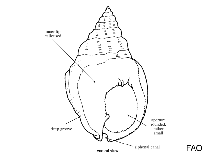Nassarius gibbosulus (Linnaeus, 1758)
Upload your photos
Google image | No image available for this species;
drawing shows typical species in Nassariidae.
Google image | No image available for this species;
drawing shows typical species in Nassariidae.
Classification / Names Common names | Synonyms | CoL | ITIS | WoRMS
Gastropoda | Neogastropoda | Nassariidae
Environment: milieu / climate zone / depth range / distribution range Ecology
Benthic. Subtropical
Distribution Countries | FAO areas | Ecosystems | Occurrences | Introductions
Mediterranean Sea.
Length at first maturity / Size / Weight / Age
Maturity: Lm ? range ? - ? cmCommon length : 1.3 cm SHL male/unsexed; (Ref. 360)
Short description Morphology
Shell: quite thick and strong, a rather high conical spire, short siphonal canal, open and twisted; body whorl is very large, spherical, covering much of the preceding one, involute, suture is hardly incised; aperture is ovoidal, outer lip has an external thickening and thin internal folds; in adults, columellar lip forms a large callus that completely covers the ventral surfaces of the body whorl; no sculpture except for a rib with one, two of three hardly visible blunt nodules, on the periphery of the dorsal surface of the body whorl; color is yellowish or yellow brown, callus and lips are white; operculum is horny, yellowish, has an apical nucleus, roughly triangular, fringed inner and outer margins. Body: wide triangular foot, many nassariids, two appendices at the posterior end; very long mantle siphon; radula is rachiglossan.
Life cycle and mating behavior Maturity | Reproduction | Spawning | Eggs | Fecundity | Larvae
This species is a non-broadcast spawner. Life cycle does not include trocophore stage. Also Ref. 833.
Main reference
References | Coordinator | Collaborators
Templado, J. and R. Villanueva. 2010. (Ref. 85339)
IUCN Red List Status (Ref. 130435: Version 2024-1)
CITES status (Ref. 108899)
Not Evaluated
CMS (Ref. 116361)
Not Evaluated
Threat to humans
Harmless
Human uses
| FishSource |
Tools
More information
Trophic Ecology
Food items
Diet
Food consumption
Ration
Predators
Diet
Food consumption
Ration
Predators
Ecology
Population dynamics
Growth
Age/Size
Length-weight
Length-length
Length-frequencies
Mass conversion
Recruitment
Abundance
Age/Size
Length-weight
Length-length
Length-frequencies
Mass conversion
Recruitment
Abundance
Life cycle
Distribution
Human Related
Aquaculture profile
Stamps, Coins Misc.
Stamps, Coins Misc.
Outreach
References
Internet sources
BHL | BOLD Systems | CISTI | DiscoverLife | FAO(Publication : search) | Fishipedia | GenBank (genome, nucleotide) | GloBI | Gomexsi | Google Books | Google Scholar | Google | PubMed | Tree of Life | Wikipedia (Go, Search) | Zoological Record



